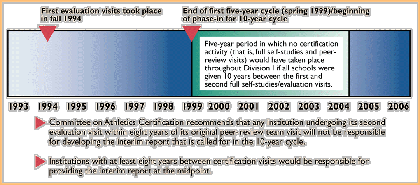The NCAA News - News and FeaturesMay 12, 1997
New certification cycle may require phase-in
The NCAA Committee on Athletics Certification has developed a number of recommendations to facilitate the transition from the current five-year Division I athletics certification cycle to the 10-year cycle that was approved at the 1997 NCAA Convention.

In examining the matter, the committee, which met April 13-14, has determined that the change from a five-year to a 10-year cycle is more complicated than it might have appeared when the change was approved in January.
The primary problem is that simply establishing a 10-year cycle at the conclusion of the five-year cycle in 1999 would create a five-year interruption in certification activity, damaging the certification infrastructure that has been developed throughout this decade.
Among other things, the interruption would mean that:
The large pool of peer reviewers would be inactive for five years, resulting in a need to retrain them upon resumption of evaluation visits.
The Committee on Athletics Certification would have no meaningful responsibilities over the five-year period, thus damaging its continuity.
The need for the significant staff support that has been developed for the athletics certification program during this decade would be vastly reduced in the five-year period.
The committee -- chaired by Southern Methodist University President R. Gerald Turner, former chair of the NCAA Presidents Commission -- believes that Division I presidents did not intend to interrupt the continuity of the program when they approved the change to a 10-year cycle in January.
With that in mind, the committee has developed a plan that phases in the new cycle.
First, an institution's placement in the initial athletics certification cycle will be taken into consideration when determining where it will be placed in the second cycle.
Second, conferences will be permitted to suggest a schedule for their member institutions. The committee is recommending that institutions with less than eight years between evaluation visits would not be required to provide the interim report that is required in the 10-year cycle.
Institutions with eight, nine or 10 years between evaluation visits would be subject to the interim-report requirement at the midpoint between evaluation visits.
The purpose is to reduce the administrative burden of institutions that are going through the full process for the second time in less than eight years.
The proposal will be forwarded to the Division I Management Council and the Division I Board of Directors.
The committee also will recommend that:
Institutions from the same conference should be scheduled evenly throughout the certification cycle so as to reduce the burden on the conference office.
Placement of institutions in the second cycle should be in conjunction with the institution's regional accreditation, as much as possible, for those institutions that so desire.
When appropriate, placement for institutions that postponed their certification activity in the initial cycle because of involvement with the Association's enforcement process will be considered case-by-case.
When the preceding principles are not operative, random selection procedures will be used.
As early as this summer, the committee will begin collecting information from conferences to aid in setting up the schedule for the second cycle.
Ultimately, after the phase-in period, athletics certification would go to a true 10-year cycle, with interim reports required at the midpoint.
Other actions
In other actions at its April 13-14 meeting, the certification committee:
Discussed a new option for coordinating site visits in relation to those of the Southern Association of Colleges and Schools. The current options are (1) conducting joint visits by the NCAA peer-review team and the SACS team or (2) holding completely separate visits for the athletics certification and accreditation teams. The new option, suggested and endorsed by SACS, involves simultaneous but separate (or concurrent) visits between the NCAA and SACS teams.
The committee and SACS believe that the third option may have merit for some institutions since it would permit campus personnel to address the athletics certification/accreditation issue at once without having to deal with the logistics of having the NCAA and SACS teams working together.
Concluded that chief executive officers, as a general rule, should be asked to chair peer-review teams in the second cycle, as they have in the first cycle.
Considered guidelines for the processing of interim reports in the second cycle (for example, could interim reports result in a change of certification status?). The committee has asked regional and specialized accrediting agencies about their policies on interim reports and will review draft guidelines for the second cycle during its next meeting.
|